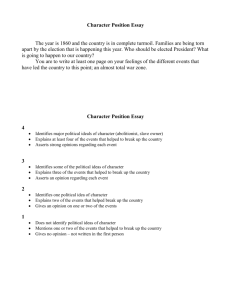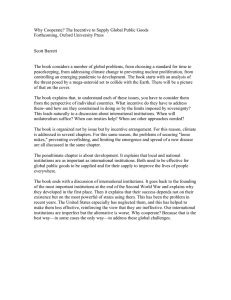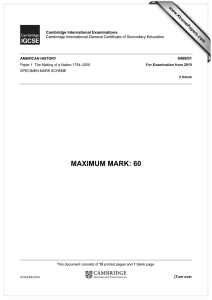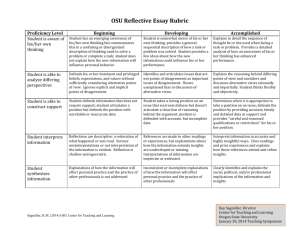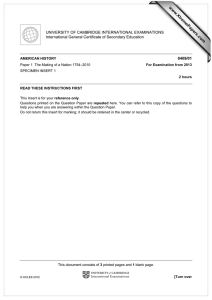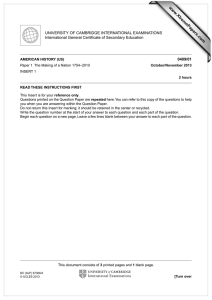www.XtremePapers.com
advertisement
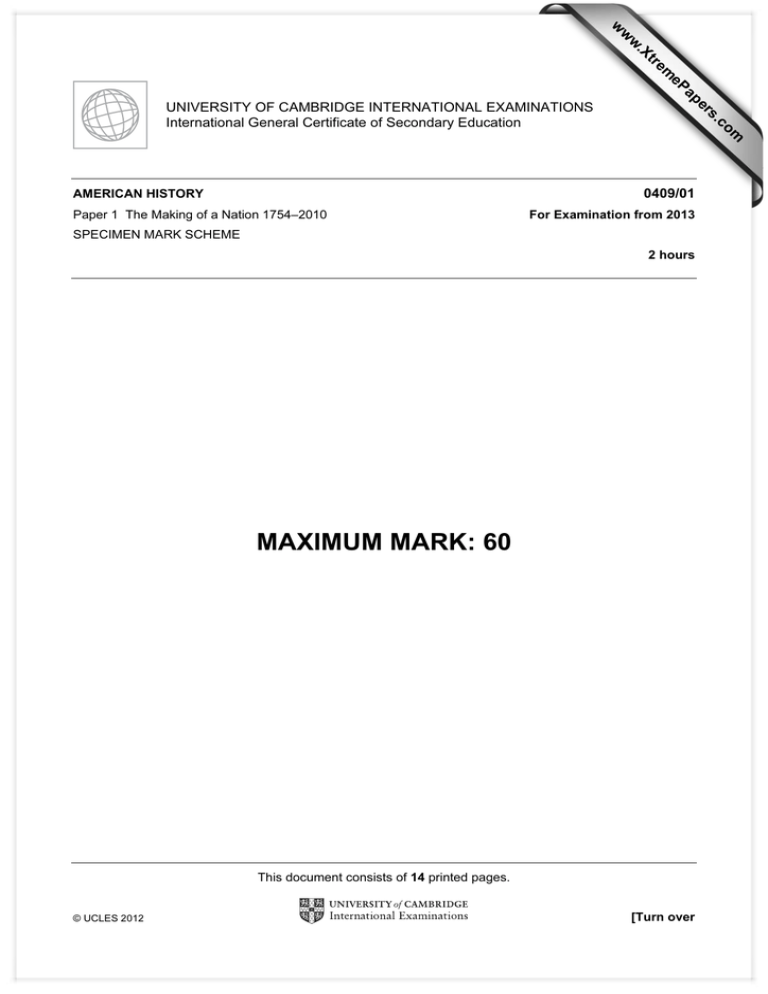
w w om .c s er AMERICAN HISTORY ap eP m e tr .X w UNIVERSITY OF CAMBRIDGE INTERNATIONAL EXAMINATIONS International General Certificate of Secondary Education 0409/01 Paper 1 The Making of a Nation 1754–2010 For Examination from 2013 SPECIMEN MARK SCHEME 2 hours MAXIMUM MARK: 60 This document consists of 14 printed pages. © UCLES 2012 [Turn over 2 Notes • • • • • The full mark range will be used as a matter of course. Marking must be positive. Marks must not be deducted for inaccurate or irrelevant material. Half-marks will not be used. Levels of response criteria are used for questions where a hierarchy of answers is possible [part (b) and (c) questions]. Each answer is to be placed in the level that best reflects its qualities. It is not necessary to work through the levels. In all levels, provisionally award the highest mark and then moderate according to the qualities of the individual answer. Arguments need to be supported with evidence. Lots of facts/dates are not required. No set answer is looked for to any question. The examples given in the marking scheme are indicative only and are not intended to be exhaustive or prescriptive. They are given only as examples of some responses/approaches that may be seen by an examiner. © UCLES 2012 0409/01/SM/13 3 Section A: Government and People 1754–2000 1 (a) What was the response of colonists to British rule from 1754 to 1776? Level 1: General answer. [1–2] e.g., “There was opposition.” Level 2: Describes events. [3–5] e.g., “The colonists called for a congress at Albany, New York, to discuss united action against British rule.” “In 1765, Bostonians rioted against the 1765 Stamp Act.” (b) Explain the importance of the Second Party system in the development of American politics before 1860. Level 1: General answer. [1] e.g., “It made American politics more democratic.” Level 2: Identifies why. [2–4] e.g., “It was a clearly organized political party system.” “Two parties were able to challenge for votes and state offices. This made the political system more competitive.” “The system led to modern political campaigning.” “The Second Party system helped the development of American politics because parties such as the Whigs developed particular ideologies that appealed to large sections of the electorate.” Level 3: Explains why. [5–7] e.g., “Andrew Jackson’s party won every presidential election, except two, between 1828 and 1856. Defeat by the Whigs in 1840 showed how the Second Party system gave effective opposition to a popular and dominant political force.” (c) “The Union fell apart because of the election of Lincoln as president.” How far do you agree with this view? Explain your answer. Level 1: Unsupported assertions. [1] e.g., “The Union fell apart because Lincoln supported the North.” Level 2: Identifies reasons/issues. [2–3] e.g., “During 1860, there were mob attacks by southerners against suspected abolitionists and northern manufacturers.” “In Texas, fears of abolitionist plots and slave revolts led to general panic and outbreaks of vigilantism.” “The North was more advanced economically than the South.” © UCLES 2012 0409/01/SM/13 [Turn over 4 Level 3: Explains agreement OR disagreement. [3–5] e.g., “The Union fell apart due to the issue of slavery, not Lincoln’s election. Republicans in the North found slavery to be immoral whereas those in the South saw it as necessary for economic stability. Lincoln knew he had to tackle the slavery issue if the Union was to be kept intact. He said ‘What I do about slavery and the colored race, I do because it helps save this Union.’ So he planned to emancipate the slaves.” “Confidence had grown in the South that it could survive alone without the help of the North. This confidence was based on the wealth generated by King Cotton and on the result of the Dred Scott Case which in effect made the Missouri Compromise unconstitutional. So Lincoln’s election threatened the South and his policies led to secession.” Level 4: Explains agreement AND disagreement. [5–7] Both sides of Level 3. Level 5: Explains with evaluative judgment of “How far …? 2 [7–8] (a) Describe the main features of the Reconstruction period (1865 to 1877). Level 1: General answer. [1–2] e.g., “The Civil War ended and there was peace.” Level 2: Describes events. [3–5] e.g., “Carpetbaggers and Scallywags dominated the Reconstruction governments in the South.” “By 1870, all the former rebel states were back in the Union.” (b) Explain the growth of Populism from 1867 to 1896. Level 1: General answer. [1] e.g., “Populism grew because rural people felt isolated.” Level 2: Identifies why. [2–4] e.g., “The Granger Movement tried to help farmers feel they were part of a bigger community.” “The Greenback Party, founded in 1875, helped farmers to pay off their debts.” Level 3: Explains why. [5–7] e.g., “The Granger Movement helped farmers by supporting the set up of farm-owned cooperatives for buying and selling of goods directly, without going through a middleman. The Movement also used political action to promote the interests of members and by 1873 or 1874 there were Granger representatives in 11 state governments.” © UCLES 2012 0409/01/SM/13 5 (c) “The most important achievement of the Progressive Movement (1901 to 1920) was female suffrage.” How far do you agree with this view? Explain your answer. Level 1: Unsupported assertions. [1] e.g., “Female suffrage was very important as it gave women greater rights.” “The Progressive Movement was not just about achieving female suffrage. It also improved American politics and society.” Level 2: Identifies reasons/issues. [2–3] e.g., “‘The Wisconsin Idea’ of La Folette was popular as it challenged powerful business interests such as the railroads.” “Because of Populism, ordinary people were encouraged to get involved in politics through reforms such as the recall, the direct primary, and the direct election of senators.” Level 3: Explains agreement OR disagreement. [3–5] e.g., “Female suffrage was the Progressive Movement’s most important achievement. Progressives supported the women’s suffrage movement and as a result Congress passed the Nineteenth Amendment, which gave the vote to all American women. It also paved the way for women to become more directly involved in politics and government.” “The women’s suffrage movement had started way before the coming of the Progressive Movement. The first Convention for Women’s Rights was in 1848. So all the Progressive Movement did was to help the suffrage movement gain momentum.” “The Progressive Movement had more important achievements than female suffrage. For example, Theodore Roosevelt was responsible for introducing the ‘square deal’ designed to help business people, farmers, consumers, and workers (i.e., all Americans). In particular, this meant helping those experiencing economic hardship, such as miners. In 1903, Roosevelt ‘encouraged’ mine owners to increase wages by 10% and introduce a 9-hour day.” Level 4: Explains agreement AND disagreement. [5–7] Both sides of Level 3. Level 5: Explains with evaluative judgment of “How far …? © UCLES 2012 0409/01/SM/13 [7–8] [Turn over 6 Section B: Who are Americans 1754–2000? 3 (a) Describe the impact of slavery on the lives of African Americans before 1861. Level 1: General answer. [1–2] e.g., “Slaves were treated badly.” Level 2: Describes events. [3–5] e.g., “African Americans were not citizens. As slaves, they were forced to work long hours on plantations picking crops in return for shelter. Many were beaten and starved.” (b) Explain the importance of the Harlem Renaissance to the development of American culture before 1945. Level 1: General answer. [1] e.g., “It provided new kinds of music.” Level 2: Identifies why. [2–4] e.g., “Harlem became the national center for jazz.” “Harlem writers such as James Weldon Johnson showed how literature could be used to express radical political views.” Level 3: Explains why. [5–7] e.g., “The Harlem Renaissance was very important because it revealed a distinct African American culture. African American writers such as Claude McKay and Langston Hughes showed that African Americans could produce work of the same quality as anyone else.” (c) “Martin Luther King’s role in helping African Americans gain civil rights has been greatly exaggerated.” How far do you agree with this view? Explain your answer. Level 1: Unsupported assertions. [1] e.g., “Martin Luther King was a good speaker who influenced people.” Level 2: Identifies reasons/issues. [2–3] e.g., “Martin Luther King was very important. He led the Montgomery bus boycott in 1955.” “King was an inspirational speaker, as he showed at the end of the March on Washington.” “Other individuals and organizations made important contributions to the civil rights movement, including Ella Baker, SNCC and CORE.” Level 3: Explains agreement OR disagreement. [3–5] e.g., “King used his skills as an effective speaker to encourage people to work together to end segregation, as in his speech at the end of the March on Washington. He preached nonviolent political protest, which won support from a wide range of individuals and groups. This led to the passing of the 1964 Civil Rights Act and the 1965 Voting Rights Act.” “Martin Luther King’s role has been exaggerated as the civil rights movement was already making progress before he came on the scene. For example, the NAACP had already © UCLES 2012 0409/01/SM/13 7 achieved success with the 1954 Brown v. Board of Education judgment. As Ella Baker famously said, ‘The movement made Martin rather than Martin making the movement.’” Level 4: Explains agreement AND disagreement. [5–7] Both sides of Level 3. Level 5: Explains with evaluative judgment of “How far …?” 4 [7–8] (a) Describe the outcome of the Indian Wars of the 1870s. Level 1: General answer. [1–2] e.g., “Many Native Americans and settlers were massacred.” Level 2: Describes events. [3–5] e.g., “The Blackfoots and Crows were pushed out of Montana. The Utes lost land in Colorado and the Nez Perces were driven from Idaho.” “Geronimo was captured in 1877, ending resistance from the Apaches.” “The Sioux defeated Custer at The Little Big Horn in 1876 but, after a year, they were forced to hand over their hunting grounds.” (b) Explain the impact of the policy of assimilation on Native Americans before 1945. Level 1: General answer. [1] e.g., “Native American society was destroyed.” “The hunting of animals stopped.” Level 2: Identifies reasons/issues. [2–4] e.g., “The Dawes Act of 1887 changed how Native Americans lived.” “The 1934 Indian Reorganization Act tried to protect Native American culture.” Level 3: Explains why. [5–7] e.g., “The Dawes Act of 1887 helped destroy Native American culture. The education of children was ‘westernized’. Collective tribal ownership of land was not allowed, and land was sold off to settlers and property speculators. By 1934, the land given to Native Americans (including reservations) in 1887 had been reduced by over 60%.” (c) “The achievements of the Red Power movement were very limited before 1980.” How far do you agree with this view? Explain your answer. Level 1: Unsupported assertions. [1] e.g., “Red Power was too radical and, therefore, achieved very little.” Level 2: Identifies why. [2–3] e.g., “AIM was founded in 1968 to campaign against police brutality of elders, women, and children.” © UCLES 2012 0409/01/SM/13 [Turn over 8 “AIM members occupied the Wounded Knee battle site in 1972 and got the support of Hollywood movie stars such as Marlon Brando.” Level 3: Explains agreement OR disagreement. [3–5] e.g., “The Red Power movement failed to improve the economic and social conditions of Native Americans. Poverty remained, and could be made even worse by ‘independent’ Native American nations introducing casinos on reservations. This started to divide nations such as the Mohawks.” “Red Power achieved a lot because it influenced the introduction of the 1974 Indian SelfDetermination Act. Control over federal aid programmes on reservations was given to Native Americans. They also had more say over the education of their children.” Level 4: Explains agreement AND disagreement. [5–7] Both sides of Level 3. Level 5: Explains with evaluative judgment of “How far …?” © UCLES 2012 0409/01/SM/13 [7–8] 9 Section 3: Economic and Social Change 1754–2000 5 (a) Describe the effects of industrialization on working and living conditions from 1877 to 1914. Level 1: General answer. [1–2] e.g., “Work was dangerous and had bad effects on the health of workers.” Level 2: Describes events. [3–5] e.g., “Industrialization led to rapid urbanization. By the 1880s, the population density in the slums of East Side New York was very high.” “Industrial urbanization caused major health problems. Urban death rates in the early Twentieth Century were 16–17 per thousand. Industrial accidents were common. In 1904, for example, 27, 000 workers died through job related causes.” (b) Explain why there was a consumer boom in the 1920s. Level 1: General answer. [1] e.g., “People spent more money on goods for their homes.” “More goods and services were being produced.” Level 2: Identifies why. [2–4] e.g., “Far more consumers were now able to buy what had once been luxury goods.” “Firms such as General Motors grew very big and used new production methods.” Level 3: Explains why. [5–7] e.g., “By 1927 General Motors, Ford, and Chrysler had formed the ‘Big Three’. By using new production line techniques and operating on a big scale, they were able to make many more cars at a much lower price. This gave many families access to a car.” “Electric power spread in popularity. By 1927, over 60% of the population had electric lighting (compared to 16% in 1913). Electricity was also used to power new household equipment such as refrigerators and washing machines.” “New consumer and hire purchase schemes were introduced. This allowed people to buy goods over a period of time through weekly or monthly repayments, and be charged interest on the loan. For example, by 1929, 70% of all furniture bought by Americans was sold on credit.” (c) “The New Deal was a failure.” How far do you agree with this view? Explain your answer. Level 1: Unsupported assertions. [1] e.g., “The New Deal failed to help the poor.” Level 2: Identifies reasons/issues. [2–3] e.g., “From 1933 to 1938, Roosevelt set up ‘alphabet agencies’ to help the economy recover.” “The 1933 National Industrial Recovery Act put people back to work.” © UCLES 2012 0409/01/SM/13 [Turn over 10 Level 3: Explains agreement OR disagreement. [3–5] e.g., “The New Deal was successful. It resulted in the creation of many jobs and a fall in poverty. The Civilian Conservation Corps, for example, employed millions of young people to build public works such as roads and dams.” “The New Deal was not so important. Its measures only softened the impact of the crisis. Unemployment remained at 15%–20% for most of the late 1930s.” Level 4: Explains agreement AND disagreement. [5–7] Both sides of Level 3. Level 5: Explains with evaluative judgment of “How far …?” 6 [7–8] (a) Describe how industry developed in America from 1865 to 1914. Level 1: General answer. [1–2] e.g., “Many industries took off and this created more jobs.” Level 2: Describes events. [3–5] e.g., “By 1900, the U.S.A. was producing about one-third of the world’s manufacturing goods.” “The number employed in manufacturing, mining, construction, and services had increased from ca.4 million in 1865 to ca.18 million in 1900.” “Major industries were organized into trusts or holding companies.” (b) Explain why there was a Great Crash in October 1929. Level 1: General answer. [1] e.g., “Investors had become greedy.” Level 2: Identifies why. [2–4] e.g., “The Bank of England raised interest rates to 6.5% in October 1929 to attract investors.” “On 24 October 1929 (Black Thursday), U.S. share prices collapsed as millions of shares were sold.” Level 3: Explains why. [5–7] e.g., “By lowering interest rates in October 1929, the Bank of England encouraged U.S. investors to sell shares on the U.S. New York Stock Exchange and switch their investments to Britain. Share prices in the U.S. fell and shareholders started to sell their stocks. By the end of Black Thursday, share values had fallen by about $4 billion.” (c) “The most significant impact of the ‘information age’ was on the economy.” How far do you agree with this view? Explain your answer. Level 1: Unsupported assertions. © UCLES 2012 [1] 0409/01/SM/13 11 e.g., “The ‘information age’ created more employment.” Level 2: Identifies reasons/issues. [2–3] e.g., “The production of computers greatly increased. By 2000, 51% of American households owned a computer.” “By 1998, Microsoft was worth $200 billion, which made it the world’s second most valuable company.” Level 3: Explains agreement OR disagreement. [3–5] e.g., “As a result of the information age, the U.S. experienced its greatest period of economic expansion. Waves of ‘dot com’ companies emerged. New types of entrepreneur appeared. For example, Bill Gates dropped out of Harvard to set up a company that was to become Microsoft. By the age of 31, he was a billionaire.” “The most significant impact of the information age was on government. Governments had to face up to new types of domestic issues related to privacy, copyright, and monopolies. For example, a federal judge ordered the Napster Internet company to stop trading in song files as they were copyrighted by record companies.” Level 4: Explains agreement AND disagreement. [5–7] Both sides of Level 3. Level 5: Explains with evaluative judgment of “How far …?” © UCLES 2012 0409/01/SM/13 [7–8] [Turn over 12 Section 4: America and the World 1754–2010 7 (a) What did America do to attempt to secure international peace in the inter-war period (1918 to 1939)? Level 1: General answer. [1–2] e.g., “America held discussions with other countries.” Level 2: Describes events. [3–5] e.g., “Wilson’s 14 Points had a big influence on Versailles and other peace settlements.” “The Young Plan (1929) gave financial help to defeated countries in Europe, especially Germany, by reducing their reparations bill. But in the 1930s, the U.S.A. did very little.” “America helped broker the Kellogg-Briand Pact (1928), which was originally an agreement between France and America to try to prevent future wars. Other countries signed later.” (b) Explain the importance of America’s role during the Yalta and Potsdam conferences (1945). Level 1: General answer. [1] e.g., “America planned the future of Europe.” Level 2: Identifies why. [2–4] e.g., “America agreed to help set up a new peacekeeping organization, to be called the United Nations.” “At Yalta, Roosevelt supported the idea that Germany should be divided temporarily into zones, one of which America would administer. At Potsdam, Truman told the Russians about atomic weapons.” Level 3: Explains why. [5–7] e.g., “At Yalta, Roosevelt and Churchill refused Stalin’s request for the Soviet Union to be paid reparations of $20 billion by Germany. This angered the Russians and added to growing tensions between East and West.” “During the Potsdam Conference, Truman received news that an atomic test bomb had been successfully exploded. Truman issued the Potsdam Declaration, which told Japan to surrender unconditionally or face ‘prompt and utter destruction’. After Japan refused, the first atomic bomb was dropped on Hiroshima.” (c) “The main aim of the Marshall Plan (1947) was to bring prosperity to Europe.” How far do you agree with this view? Explain your answer. Level 1: Unsupported assertions. [1] e.g., “The Marshall Plan created peace in Europe.” Level 2: Identifies reasons/issues. [2–3] e.g., “The Plan was an economic and financial package meant to help European recovery.” “The Marshall Plan was an economic development of the Truman Doctrine.” © UCLES 2012 0409/01/SM/13 13 Level 3: Explains agreement OR disagreement. [3–5] e.g., “The Marshall Plan was also known as the European Recovery Program. George Marshall said his policy was ‘directed not against any country or doctrine but against hunger, poverty, desperation, and chaos’. A main aim was to help European economies recover, which in turn would provide bigger markets for American goods and services.” “The main objective of the Marshall Plan was political. There would be much less chance of communism spreading across Europe if it was helped to recover from the destruction of the war and the people had a job with good pay.” Level 4: Explains agreement AND disagreement. [5–7] Both sides of Level 3. Level 5: Explains with evaluative judgment of “How far …?” 8 [7–8] (a) Describe the U.S.A.’s role in the Korean War (1950 to 1953). Level 1: General answer. [1–2] e.g., “The U.S.A. tried to stop communism spreading.” Level 2: Describes events. [3–5] e.g., “Truman ordered military supplies to be sent to South Korea from U.S. bases in Japan.” “Truman got the United Nations to support military action in Korea. U.S. forces led the fighting against North Korean and Chinese soldiers. American generals commanded the U.N.–backed troops.” (b) Explain why the U.S.A. got involved in Vietnam from 1954 to 1964. Level 1: General answer. [1] e.g., “America wanted to stop communism.” Level 2: Identifies why. [2–4] e.g., “The U.S.A. did not accept the Geneva Accords of 1954, but gave support to Ngo Dinh Diem.” “Eisenhower believed in the Domino Theory.” Level 3: Explains why. [5–7] e.g., “Eisenhower and Kennedy believed the spread of communism must be contained and believed in the Domino Theory. They thought that Ho Chi Minh would take over the whole of Vietnam, which would encourage other SE Asian countries to turn to communism. Therefore, they helped the government of South Vietnam. By the end of 1963, about 23,000 U.S. advisers were in South Vietnam.” © UCLES 2012 0409/01/SM/13 [Turn over 14 (c) “The skill of President Kennedy was the main reason why the Cuban Missile Crisis (1962) was handled successfully.” How far do you agree with this view? Explain your answer. Level 1: Unsupported assertions. [1] e.g., “Kennedy was clever and brave and solved the problem.” Level 2: Identifies reasons/issues. [2–3] e.g., “Kennedy announced that Cuba would be ‘quarantined’ and Khrushchev ordered the Soviet ships heading for Cuba to return home.” Level 3: Explains agreement OR disagreement. [3–5] e.g., “Kennedy showed great skill in using the experience and ideas of advisers such as Robert Kennedy and Dean Acheson. He weighed up different options carefully before making decisions about what action to take. He was intelligent in calling for a ‘quarantine’ of Cuba (rather than blockade) as this sounded less warlike. He responded carefully to Khrushchev”s letters of 26 and 27 October. His approach prevented a nuclear war.” “At all times during the Crisis, the key decisions were made by Khrushchev. The Russian leader was careful not to let the crisis get out of hand. His long letter of 26 October offered a compromise in which missiles would be removed from Cuba as long as the ‘quarantine’ was lifted and the U.S.A. agreed not to invade the island. Kennedy agreed to these terms, and in doing so made Castro’s position in Cuba much stronger. The Cuban Crisis showed that Kennedy was weak.” Level 4: Explains agreement AND disagreement. [5–7] Both sides of Level 3. Level 5: Explains with evaluative judgment of “How far …?” © UCLES 2012 0409/01/SM/13 [7–8]
